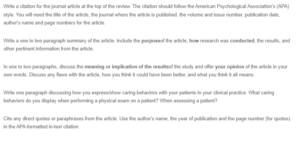Article Review – Comparing the Caring Behaviors Exhibited by Nursing Students and Registered Nurses
Li, Y. S., Yu, W. P., Yang, B. H., & Liu, C. F. (2016). A comparison of the caring behaviours of nursing students and registered nurses: Implications for nursing education. Journal of clinical nursing, 25(21-22), 3317-3325. https://doi.org/10.1111/jocn.13397
Article Summary
The article aims to explore and compare the caring behaviors exhibited by nursing students and registered nurses and its implications for nursing education. The researchers conducted a cross-sectional study in which they collected data from 206 nursing students and 236 registered nurses in China using the Chinese version of the Caring Behaviors Inventory (CBI). The CBI consists of 38 items related to caring behaviors in nursing practice, and participants rated the frequency of these behaviors on a Likert scale. According to Li et al. (2016), “Nursing students obtained significantly higher scores on the Caring Behaviors Inventory (CBI) than registered nurses (t = 3.49, p < 0.01), which indicated that nursing students had a more idealistic perception of caring behaviours than registered nurses” (p. 18). The study highlights the need for nursing education to bridge the gap between the theoretical understanding of caring and its practical application in nursing practice.
Meaning and Implications of the Results
The study’s findings suggest that there may be a discrepancy between the perception of caring behaviors among nursing students and the actual practices of registered nurses. This implies that nursing education should focus on imparting theoretical knowledge about caring and promoting the development of practical skills in caring behaviors. It is essential to provide nursing students with ample opportunities for hands-on experiences, mentorship, and exposure to real-life patient care scenarios to enhance their understanding and application of caring behaviors in clinical practice.
The article sheds light on a crucial aspect of nursing education and practice. It emphasizes the need for nursing programs to incorporate more experiential learning and mentorship opportunities to bridge the gap between theoretical knowledge and practical application of caring behaviors. By fostering a culture of empathy, compassion, and patient-centered care in nursing education, future nurses can be better equipped to provide high-quality and holistic care to their patients.
One potential area for improvement in the study could be the limitation of the sample being restricted to a specific region in China, which might limit the generalizability of the results to other cultural contexts. Moreover, using a self-reported instrument like the CBI could introduce response biases, as participants may tend to answer in a socially desirable manner. To improve the study, a more diverse and representative sample from different regions and cultures could be considered, and the researchers could utilize a mix of self-report and observational methods to assess caring behaviors.
Caring Behaviors in Clinical Practice
In my clinical practice as a nurse, I express caring behaviors by actively listening to my patients, showing empathy, and treating them with dignity and respect. During physical exams, I explain the procedures to the patients, provide privacy and maintain a calm and reassuring demeanor to alleviate any anxiety they may have. When assessing patients, I take a holistic approach, considering their physical symptoms and emotional and psychological well-being. Additionally, I involve patients in decision-making and actively engage with them to understand their preferences and concerns.
References
Li, Y. S., Yu, W. P., Yang, B. H., & Liu, C. F. (2016). A comparison of the caring behaviours of nursing students and registered nurses: Implications for nursing education. Journal of clinical nursing, 25(21-22), 3317-3325. https://doi.org/10.1111/jocn.13397
ORDER A PLAGIARISM-FREE PAPER HERE
We’ll write everything from scratch
Question
Write a citation for the journal article at the top of the review. The citation should follow the American Psychological Association’s (APA) style. You will need the title of the article, the journal where the article is published, the volume and issue number, publication date, author’s name and page numbers for the article.

Comparing the Caring Behaviors Exhibited by Nursing Students and Registered Nurses
Write a one to two paragraph summary of the article. Include the purposeof the article, how research was conducted, the results, and other pertinent information from the article.
In one to two paragraphs, discuss the meaning or implication of the resultsof the study and offer your opinion of the article in your own words. Discuss any flaws with the article, how you think it could have been better, and what you think it all means.
Write one paragraph discussing how you express/show caring behaviors with your patients in your clinical practice. What caring behaviors do you display when performing a physical exam on a patient? When assessing a patient?
Cite any direct quotes or paraphrases from the article. Use the author’s name, the year of publication and the page number (for quotes) in the APA-formatted in-text citation.


